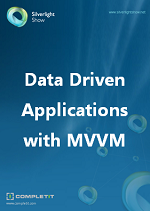

Data Driven Applications with MVVM
Author: Zoltan Arvai
Price: $0.99 
Format: PDF,Word, EPUB, MOBI. All source code added to the downloadable package.
Number of pages: 27
Release date: July 2011
This e-book collects the 3 parts of SilverlightShow article series 'Data Driven Applications with MVVM', together with source code. Explore MVVM with the convenience of a fully offline resource!
From the author: This e-book covers what MVVM is and how to use it in practice, how to solve issues when applying this pattern and how to take advantage from it.
What is MVVM and why you need it
Do you know the feeling, when you start to develop an application, and in the first couple of days you feel good because you made a really good progress? Do you know the feeling, when after a couple of days, you feel that your design is not that best and when you have to modify a little code, you are afraid of the effect it might have on other parts of you code? The first sign of a bad design is when applying a hack is easier than to implement it the proper way. At the end of the week you already have spaghetti code. You have logic that is not testable, it is very tightly coupled with the UI. You cannot make just “minor” changes without taking risks. If someone wants to understand your code, it takes days or weeks to figure out how it works.
This is where MVVM comes into play. MVVM stands for the Model – View – ViewModel pattern. It’s originated from MVC and is specific to WPF and Silverlight. The three most important things that MVVM can offer you:
- Testable code
- UI is loosely coupled with related logic
- Maintainable code
Inside each chapter you may find a link to the source code used throughout the chapter examples. All source codes are available inside the e-book package.
Contents:
Chapter 1: The Basics
Introduction
What is MVVM and why you need it
Basic concepts in MVVM
The Layers
Interaction between the Layers
MVVM in practice
1. The Model Project
2. The ViewModels
3. The Views
4. Wiring Up
Chapter 2: Messaging, Unit Testing, and Live Data Sources
Introduction
Adding Remove functionality – Messaging
Unit testing MVVM
Changing to Live, WCF-based Data Source
Chapter 3: Validation, Bringing the UI Closer
Introduction
Validation in MVVM
Bringing the UI and the ViewModels more closely
Final thoughts
About the author:
 Zoltan Arvai is a Silverlight MVP from Hungary. He owns a small company called NextGen Solutions Kft focusing on Training and Consulting. He specialized in .NET (mostly in Silverlight, Windows Presentation Foundation and Windows Phone 7) and in Application Lifecycle Management (Team Foundation Server 2010 + VS2k10).
Zoltan Arvai is a Silverlight MVP from Hungary. He owns a small company called NextGen Solutions Kft focusing on Training and Consulting. He specialized in .NET (mostly in Silverlight, Windows Presentation Foundation and Windows Phone 7) and in Application Lifecycle Management (Team Foundation Server 2010 + VS2k10).
You can find his tech blog here: http://zoltanarvai.com/. He tweets from @zoltanarvai.